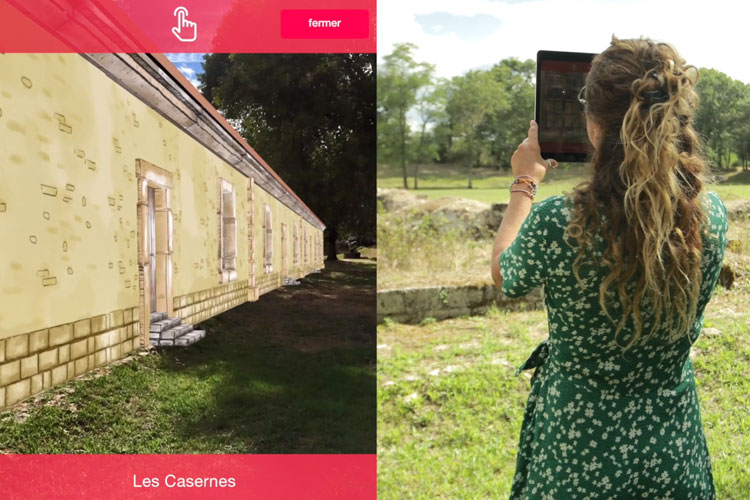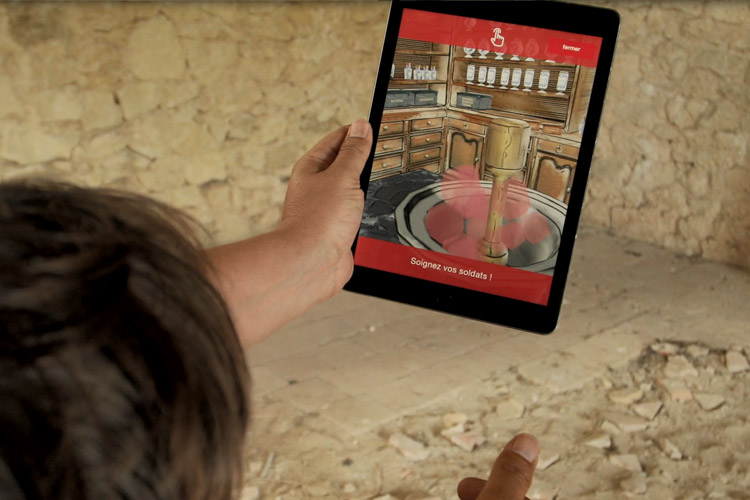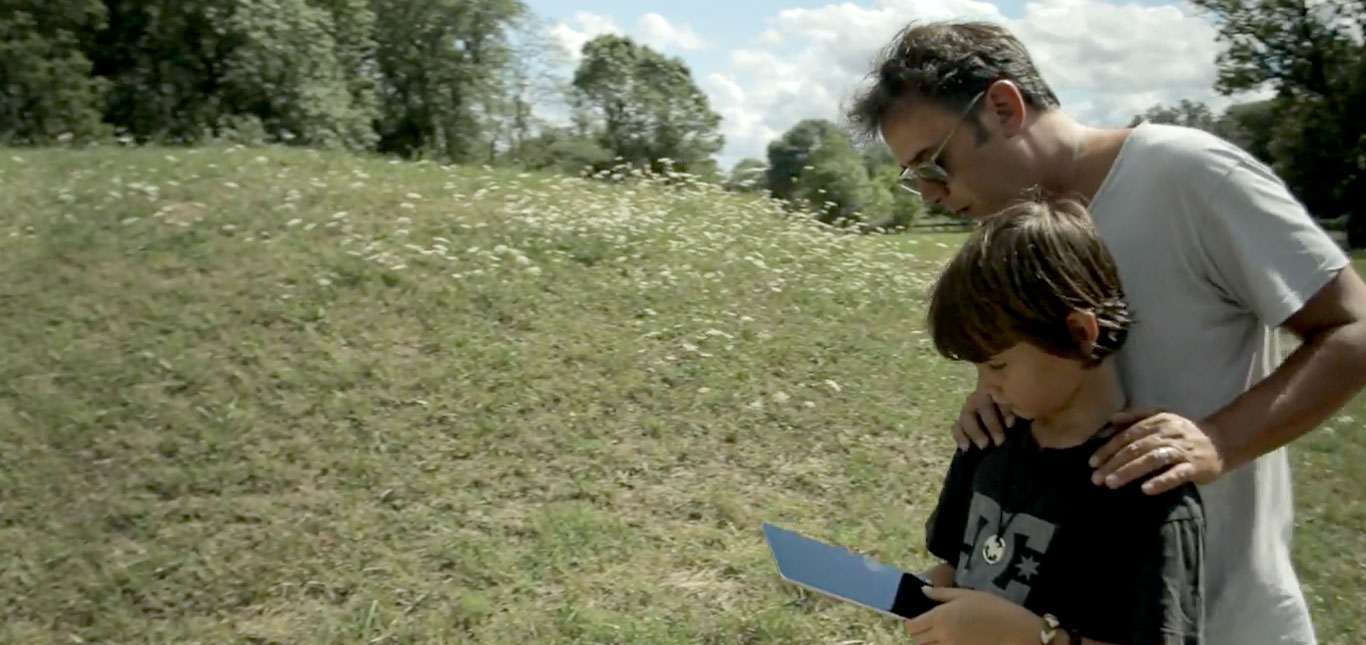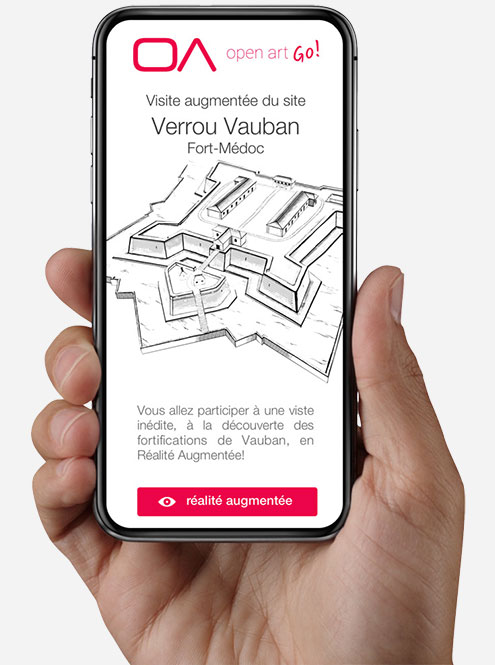- Develop AR Experiences with Vuforia Engine
- Vuforia Engine Features and Functionality for AR App Development
- AR for Sales & Marketing
DreamCorp transforms the way that people engage with brands, art, and history
DreamCorp is a multimedia and entertainment company based in Paris, France that produces immersive art experiences and interactive events for brands using Virtual Reality (VR), Augmented Reality (AR), and virtual filming (XR) projects. Stan Walbert, CEO and Artistic Director, and Guillaume Buisson, Chief Technology Officer, founded the company in 2014—seven years later, DreamCorp has six employees who specialize in the design and implementation of immersive technologies. Their work can be found in a variety of settings and forms: 3D real-time backdrops on film sets powered by AR, immersive VR art exhibitions, and events with interactive activities for guests.
DreamCorp reimagined how visitors interact with historical sites
Drawing inspiration from their friends in the art and antiquities world, DreamCorp decided to focus on historical sites. They noticed that places rich with history, like the Bordeaux region of France, lacked easily accessible information on major historical sites; specifically, they noticed that there was no digital offering to fill this gap.
DreamCorp understood the potential of AR to reinvigorate how tourists engage with history, and they set out to create a self-guided experience that would bring historical sites to life and provide easily accessible information to tourists. Their goal was threefold: DreamCorp set out to create interactive, visually intriguing experiences that shift how people engage with history; to provide interactive and innovative explanations about art and history without the need for a tour guide or static signage; and to blend the physical and digital worlds to create an impactful experience that is enhanced, but not overwhelmed, by digital technology.
Because AR can work on almost any smart phone or tablet, DreamCorp recognized that they could use AR to reach a broad audience with an accessible, easy-to-use experience of art and history. However, historical sites pose unique challenges because they are highly regulated, creating barriers to innovation. For example, UNESCO World Heritage sites have strict regulations that limit certain technologies like QR codes or other tracking devices. Traditionally, these regulations have reinforced the audio-driven tour, which leads to an individualized experience of a historical site. DreamCorp wanted to build something that allows for a communal experience of history. In order to achieve their goals, DreamCorp needed to find a solution that would enable interactive, self-guided experiences in compliance with UNESCO World Heritage regulations.

Vuforia Engine was key to the creation of the OpenArt GO! app
~ Stan Walbert CEO and Artistic Director of DreamCorp
DreamCorp leveraged Vuforia Engine to create their AR-powered application, OpenArt GO!, which is an app that users download on their phone or tablet and can then use to explore historical sites. They simply point their device’s camera at any part of the site and OpenArt GO! will generate immersive, augmented experiences. By blending the physical and digital worlds, OpenArt GO! allows users to engage with historical spaces in a way that combines the past and present— expanding the imagination of visitors through stunning visualizations and interactive content.
Vuforia Engine is the leading development software for creating powerful, photo-realistic AR experiences. While it’s often difficult to create an AR experience in a large, open space, Vuforia Engine addresses this challenge. Area Targets, Vuforia Engine’s most recent, innovative capability, is an environment tracking feature that allows a physical space to be tracked and augmented.
Area Targets are created using an accurate 3D scan of the environment from a scanning device, such as Matterport or the Vuforia Target Creator Application on an iPhone or iPad. The Area Target makes the environment recognizable in an application or development platform so that designers can place digital content within it. The digital content can be seen when the application is started within that physical space. This technology enables the creation of games, navigation applications, and spatial instructions that use the surroundings as interactive elements to be explored.
“We tried a few other solutions before turning to PTC’s Vuforia Engine. When we started working with Vuforia Engine, it was easy to deploy and integrated right away with our Matterport camera scans. Support from PTC was amazing throughout the process,” says Stan Walbert. It was essential to DreamCorp’s success to find a solution that could rise to the challenge of developing AR experiences in a large venue with multiple buildings. DreamCorp chose Vuforia Engine due to its speed of development, ease of implementation, strong customer support from PTC, and its powerful computer vision technology that offers accurate tracking for high-performance AR experiences.
Bringing the history of Fort Médoc to life

When tourists come to Fort Médoc, they
download the OpenArt GO! app and are brought
on an interactive tour. When approaching Fort
Médoc, users with the OpenArt Go! app can
point their device’s camera at the entrance and see a digitally rendered gate that mimics the
original, 17th century design. In other parts of Fort
Médoc, visitors can use the app to visualize what
the apothecary might have looked like if it were
still furnished and fully stocked. At the Gironde
Estuary, visitors can use the app to see what
it would look like if ships were sailing towards
Bordeaux during an attack.
~ Guillaume Buisson Chief Technology Officer of DreamCorp
In addition to powerful visual overlays, the app includes explanations about specific features of Fort Médoc. Instead of visitors seeing unengaging signage or relying on a tour guide, they can use the app to learn more about the artifacts and rooms. If a user wants to engage with more details, they can click a button that says “more details” to find stories and multimedia content. For example, visitors can take an AR-enabled quiz that helps them understand what it was like to live in the barracks at Ford Médoc. Or, in the apothecary, visitors can opt into an escape game in which they must create a cure for infected, feverish soldiers. The app allows people to access different levels of information and engagement so that users can dig more deeply into the elements that interest them.
OpenArt GO! encourages visitors to look around, explore, and engage with the past while remaining connected to their friends and family throughout the experience. “The goal is that people enjoy their visits. We don’t want people to be looking at their phone the whole time. They have to look at their phone for the some of the experiences, but generally, we want them also to look at the stones and the walls and the buildings,” says Guillaume.

OpenArt GO! improves the tourist experience and opens a window into past worlds
Thanks to OpenArt GO!, users experience historical sites anew through the captivating power of AR. With this first application, DreamCorp has realized significant user engagement, reached a diverse audience, created a one-of-a-kind digital exploration of history, and received glowing feedback from clients.
DreamCorp’s seamless and intuitive user experience is accessible even to those who are unfamiliar with AR or VR, resulting in significant user engagement. This seamless design makes history and culture more approachable for people of all background and ages. DreamCorp has noticed that something special happens when families are able to engage with OpenArt Go! together: “Parents give their phone to their children, and their children play with the app, but the parents get drawn in too. There is really something shared between them. It’s a shared, engaging experience,” says Stan Walbert. This highly interactive experience allows people to learn more, engage more, and walk away with deeper insights and knowledge about Fort Médoc.
~ Stan Walbert, CEO and Artistic Director of DreamCorp
.
With positive user feedback and a vision for the future, DreamCorp is expanding OpenArt GO! to new sites and adding functionality
DreamCorp is adding new possibilities within the app for use at Fort Médoc and future sites. They are further gamifying the experience with profiles, points, and levels; allowing for deeper exploration of objects and shapes; adding social sharing; and building GPS capabilities that allow users to open the app and be led to any nearby OpenArt GO! experience.
DreamCorp has their sights set on long-term growth and continued expansion. With positive feedback from their first application of the OpenArt GO! app, DreamCorp is looking to expand and has a new site already identified for implementation. They are also creating small experiences that allow potential new sites to test the app prior to full implementation. Ultimately, the goal is to have OpenArt GO! sites throughout France and Europe so that when you open the app, a OpenArt GO! site is always within 100 kilometers.
